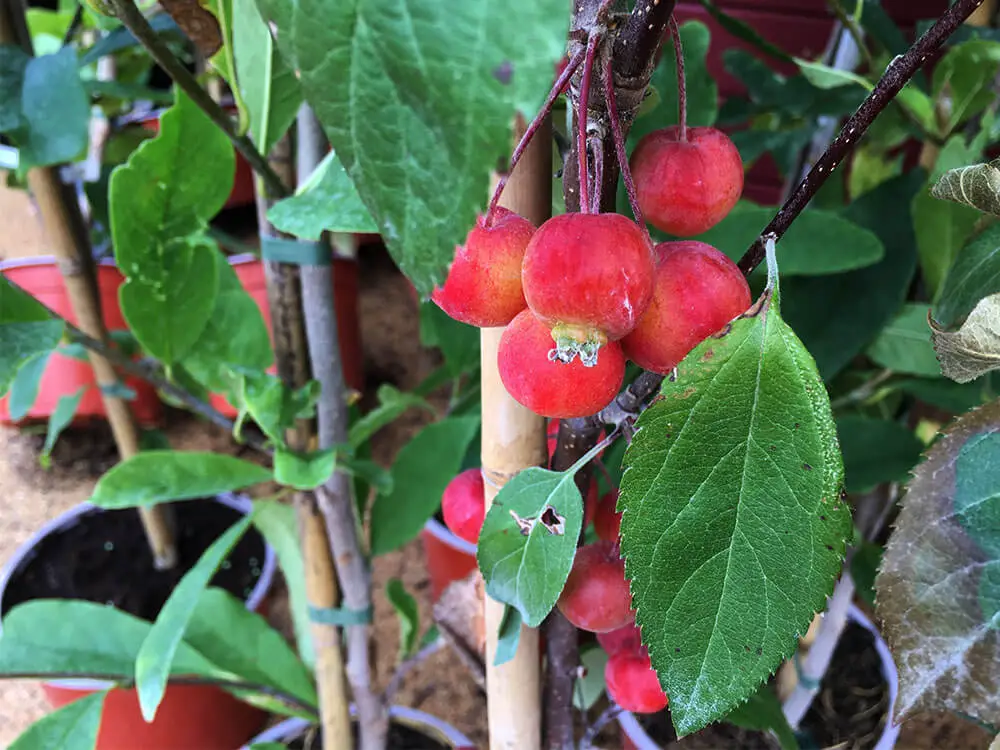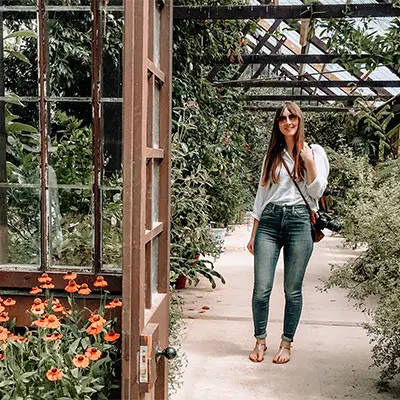A Guide to Growing Fruit Trees in Containers
October, 2022 |Growing fruit trees in containers can have so many great benefits, especially for small garden spaces. You can harvest amazing yields of fruit in a relatively small amount of space. Plus you can easily move the trees around if you want to mix up your garden layout, or even move house/apartments!
Generally, fruit trees that are planted straight into the soil in a large garden are relatively low maintenance. They have plenty of space for their branches to spread, and their roots can grow deep into the ground to find water and nutrients.
Growing fruit trees in containers however requires a little more care. They’re easy to grow, but they need a helping hand to really thrive.
We’ve covered all the key issues you need to consider when growing your own container-bound fruit tree. From advice on seasonal care throughout the year to helping you choose the best varieties!

Choose the right variety for your space
There are so many fantastic fruit trees that grow well in containers. From apricots and figs to pawpaws and peaches.
Essentially any fruit tree can be maintained in a pot, but before you head out to a local nursery or order online, you need to make sure you choose the best variety for your climate and garden space.
Make sure you check the following:
- Is it a fruit tree that would be suitable for your USDA hardiness zone?
- Do you have a height or size limit? You may need a dwarf fruit tree.
- Can the tree self-pollinate?
Consider your USDA hardiness zone
Before you pick a fruit tree make sure it’s a variety that will survive in your climate. Soft fruits like apricots and peaches will thrive in warmer states like Florida, but they’ll need heavy frost protection in more northern states.
Tropical or Mediterranean fruits will need a lot of protection during the winter months. So it’s best to double-check before spending money on a tree that might not survive the winter!
Dwarf fruit trees
If you have a really small urban space, like a balcony garden, a dwarf fruit tree could be an ideal option.
Lots of popular fruit tree varieties can be bought on dwarf rootstock. This means a cutting of that popular fruit tree variety (for example a Braeburn apple) has been grafted onto dwarf apple tree rootstock.
There can usually be a few different dwarf rootstock options available. From extreme dwarf, where a tree might reach a maximum height of 1.5m. To semi-dwarfing rootstock, which could reach heights of 3-4m.
They’re a really popular way of growing fruit trees in small spaces, as they tend to crop heavily and earlier than a larger fruit tree too!
You might like | How to Grow Apple Trees in a Small Garden

Can the fruit tree self-pollinate?
Some fruit trees can’t self-pollinate so you’ll need to make sure that you either have two of the same fruit tree (for cross-pollination) or that you buy a self-pollinating fruit tree variety.
As an example, all peach, apricot, and nectarine trees are self-pollinating. However, apples and European pears will need another apple or pear variety nearby to pollinate their flowers.
Our own Saturn peach tree is self-fertile, which means we don’t need two (and we don’t have to rely on someone else having a peach tree nearby!). Pollinators hopping between each flower on the same tree will allow cross-pollination to take place and allow the fruits to start developing!
Other considerations:
- For small balconies, an overhanging fruit tree with large apples may not be ideal for neighbors, etc. A columnar fruit tree is a great option as fruits are produced from a single fruiting trunk/branch.
- Unless you choose a very small dwarf variety, most fruit trees will need pruning at some point, so make sure you have the tools to handle this.
Choosing a container for your fruit tree
Fruit trees will need good nutrition to produce lots of fruit, so the bigger the container the better! Generally, a container width of around 20 inches and a capacity of at least 40-60 liters is best.
You’ll need to water a fruit tree in a container frequently (daily in dry spells) during the growing season, from spring to autumn. Their roots are unable to reach into the underground water supplies, so you’ll need to actively keep their container soil moist.
Although they need lots of water, fruit trees don’t like to sit in waterlogged soil, so make sure your pots and containers have good drainage.
If you’re planning to add a fruit tree to your vertical garden on a balcony, make sure you choose a container you can easily move around. A terracotta or clay pot may become heavy when filled with soil and a tree laden with fruit!

Training a fruit tree
If you’d like to control the direction of the branches, there are lots of different ways to train a fruit tree. The most popular methods are columnar (or single cordon), Espalier and fan-shaped. Each method is perfect for a small garden space, as you can direct exactly where you’d like the fruiting branches to spread.
Whether you’d like to grow an apple tree against a wall using the Espalier method or create a columnar plum tree. If you’re really tight on space, check out our guide to growing columnar fruit trees.
Pruning and maintaining a fruit tree
Unless you have a small dwarf variety, you may find that you need to prune your fruit tree from time to time. Before you start chopping at branches, it’s important to know when and how to prune…
- Pruning should usually be done in late winter or early spring before shoots begin to appear. This time of year is when the tree is still dormant and less susceptible to diseases.
- For small, young branches, you should be able to use a pair of secateurs or shears. And for larger branches, you may need a small saw. Make sure you sterilise your tools after each use to make sure there’s no possibility of spreading diseases to other fruit trees you may have.
- As a rule of thumb, you should only prune back new growth.
- Try not to remove over 20% of the total ‘top’ of the tree, as this could cause shock.

Fruit tree winter care
Some fruit trees aren’t cold-hardy so they may need protection from the cold in winter. If your area experiences constant winter temperatures of 20F and below you’ll need to take some additional steps to keep it protected…
- You can buy specially made large fleece covers for small trees which slip over the entire tree and its container. The smaller the tree and container, the more susceptible it will be to frosts and freezing temperatures.
- If you have a small greenhouse, shed, garage, or even an unheated basement you could store your fruit tree there after the leaves have fallen and the tree is dormant.
- Wind can also damage small trees, so move your container to a sheltered spot if possible.
- Placing the tree close to a window or wall may help it absorb some residual heat.
Peach trees in particular are susceptible to peach-leaf curl, so make sure you keep it frost free. Wrapping tropical fruit and soft fruit trees in fleece is one of the best ways to keep them protected through the winter.
It seems counter-productive, but it’s usually best to avoid bringing a fruit tree inside a heated home during the winter. The dry, warm air could affect the dormancy period of a fruit tree causing it to send out shoots out of season.
Fruit trees need a period of cold weather to fall into a dormant state, otherwise, they won’t produce fruit, and could die. However, extremely cold temperatures will also kill the tree, so securely protecting them outside is usually the best option.

Tips for growing fruit trees in containers
We covered several tips for growing trees in containers, but fruit trees may need a little extra support and care to produce a bumper crop. Here are a few additional tips, to keep the tree healthy and producing lots of fruit!
- Remove excess fruits if too many are clustered together on a thin branch, especially with larger fruits like apples or pawpaws. A large cluster of heavy fruits could damage small branches.
- Use supports or posts to keep the trunk stable and protected from high winds.
- Depending on the variety, you should position your fruit tree in the sunniest location in your garden space. Most fruit trees need at least 6 hours of sun a day, but always read the care instructions of the particular tree you have.
- Because they need regular watering you might benefit from a water tank or rain barrel so you can catch and use excess rainwater.
Being able to pick sweet fruits in your own garden is such a summer delight. So no matter your garden size, you could soon be picking fresh lemons on your balcony or apples from a mini container orchard in your backyard.







